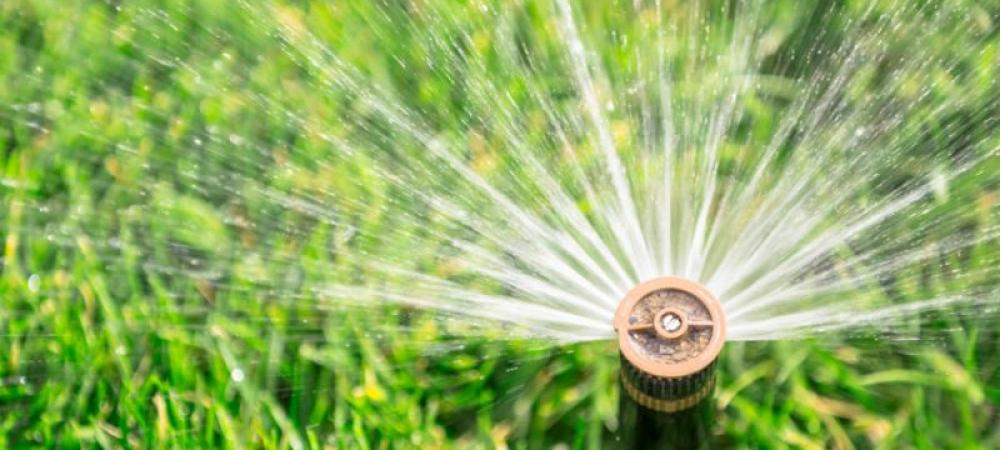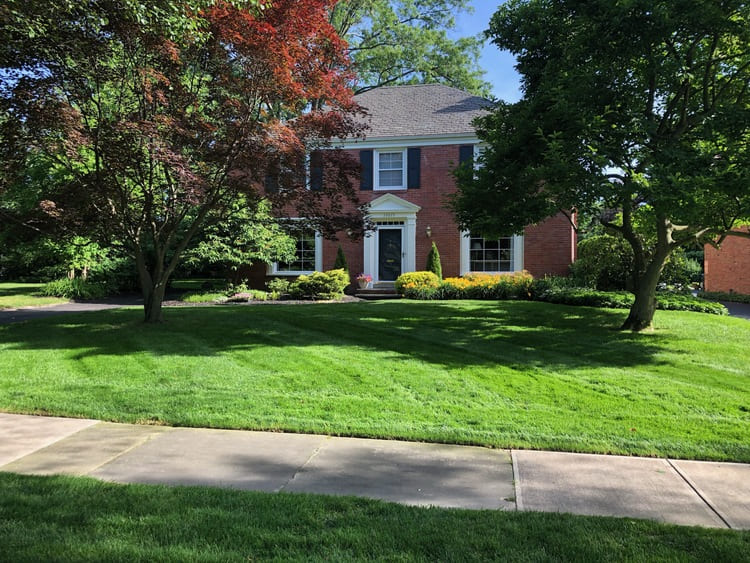The Best Time to Water Grass – Lawn Watering Tips in Northeast Ohio

It can be hard to know the best time to water grass, or how much to water your lawn. The lawn care professionals at Ecolawn are here with their best lawn watering tips for Mentor, Ohio and beyond.
The best time to water your lawn is early in the day when it’s cool. Early morning grass watering reduces the amount of evaporation that takes place, allowing more water to reach the root zone.
Avoid late morning or afternoon watering because it evaporates in the heat. Up to 50% of landscaping water can evaporate in the summer. So, picking the right time of day to water is both eco-conscious and wallet-friendly.
It’s also not ideal to water the lawn in the evening. Leaving your grass wet overnight can cause extensive fungal lawn diseases, such as dollar spot, brown patch, and others.
Most experts recommend watering between 6 and 10 am for optimum water conservation.
How Often to Water Grass
Many factors, such as the soil quality and weather influence how much water your lawn needs. In general, your lawn needs about 1-1.5 inches of water per week to stay green and growing. Rain doesn’t always fall at the right time, so you may want to supplement your lawn with additional water.
Deep, infrequent watering is best. 20 minutes every other day will usually give your lawn the right amount of moisture, but there are easy tests you can do to know exactly how long and how frequently you should water your lawn.
Use a rain gauge to measure how much water you’re applying. An empty can or plastic container will also do the trick. Set your container on a level spot near your sprinkler, turn on the water, and set a timer for 20 minutes. Based on the water level in your container, adjust your watering time to get the right amount.
After watering, you can also use a spade or shovel to test how deep the water has penetrated into the soil. The right amount of water should give you 6-8 inches of wet soil.
Finally, you can check the moisture level of your lawn with a quick walk across the grass. If the grass pops back up quickly, it has an adequate amount of moisture. Blades that don’t pop back up right away may need more water.
Avoid Too Much Water
As with watering too late at night, too much water overall can also promote brown patch and dollar spot.
Overwatering makes your lawn more prone to pests, like grubs and mosquitos. Growing grubs love water! To keep water-loving pests under control, avoid giving your lawn more water than it needs.
Spread the Water Uniformly Across the Lawn
Sprinklers vary in distribution patterns and require spray overlap for uniform coverage. Placing multiple cans or containers across the lawn can help measure water application rates. Avoid flooding areas, or missing other spots.
As with general overwatering, applying too much water in some areas can cause pooling. That can also lead to pest and disease problems.
On heavy soils and slopes, watch for excessive runoff; it may be necessary to apply the water in several shorter applications to allow for adequate penetration.
If you’re having trouble achieving uniform application, try different shapes of sprinklers to get optimum coverage. If you have a sprinkler system, you’ll want to set your sprinkler heads so that the stream of one touches the stream of the next one – wherever possible.
Monitor Rainfall
Don’t forget to factor rainfall into your schedule! You may not need to water the lawn if rain is expected soon. Keep track of rainfall for the week. Don’t apply more water to the lawn than it needs.
Water Conservation
There are many ways to help mother nature (and your water bill) by making your lawn watering routine more efficient. Here are a few of our favorites:
- Mow your lawn at a 4″ or the tallest setting,
- Limit traffic over the lawn
- Improve turf rooting
- Control thatch and soil compaction with liquid aeration.
- Set sprinklers to avoid driveways, walkways, and beds
- Use a WaterSense labeled irrigation controller for your sprinkler system.
Automatic Irrigation
Properly configured automatic sprinklers can help you conserve water and achieve more uniform coverage. However, it’s important to complete routine maintenance and program your system to avoid using excessive amounts of water. Nobody likes getting a huge water bill in the summer!
At the start of the warm season, check for leaks and broken sprinkler heads. You can also opt to add a WaterSense labeled irrigation controller added to your existing sprinkler system. WaterSense controllers adjust your watering schedule based on weather conditions or soil moisture. A smart controller can save up to 25,000 gallons of water and $280 over a season.
Want more tips for automatic irrigation? The EPA has this great guide you can use to get your sprinkler system ready to tackle the summer weather.
Let the Experts at Ecolawn Guide You!
Looking for more tips for a healthy, lush lawn in the Mentor, Ohio area? Ecolawn has been providing lawn care, perimeter pest control, flea and tick control, liquid aeration, and tree and shrub care for over 40 years. Our technicians are ready to help you achieve your lawn care goals!
FOLLOW US FOR MORE LAWN CARE TIPS

